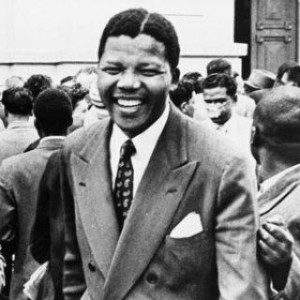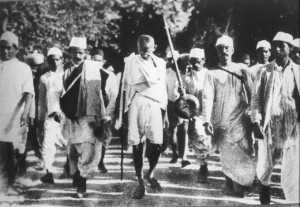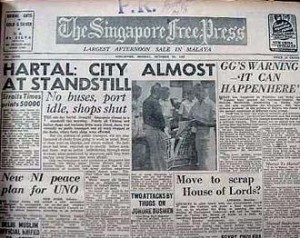A New Year Resolution: A Strategy of Protest
by Abdul Rahman
Growing up in the Mahathir era, and seeing the changes in our political landscape – from the aftermath of Operasi Lallang, to the explosive Reformasi era of Anwar Ibrahim, and a decade later, the unstoppable Bersih massive rallies, coinciding with the opening up of civil society aided by the social media, I have the hope that people power will prevail.
But now, we need a strategy. Many of us might feel helpless – what is the point of demonstrating, sweating it out and shouting till we are hoarse, coming back to our homes, only to see that the government media machine have twisted the people’s intention and nothing has changed?
Back to square one.
This is when we can take lessons from Nelson Mandela, whose recent passing inspired me to re-read his autobiography Long Walk to Freedom.
A young Mandela as a lawyer (A tribute to an Icon, Mail & Guardian madiba.mg.co.za/article/2011-05-09-in-search-of-mandelas-lost-makarov-pistol)
When Mandela was 25 years old, he participated in his first protest march, following his friend Gaur Radebe who was the founder of the African Mineworkers Union and member of the African National Congress (ANC), of which Mandela himself led in later years. Mandela wrote:
“In August 1943, I marched with Gaur and 10,000 others in support of the Alexandra bus boycott, a protest against the raising of fares from fourpence to five….The campaign had a great effect on me…I found that to march with one’s people was exhilirating and inspiring. But I was also impressed by the boycott’s effectiveness: after nine days, during which the bus ran empty, the company returned the fare to fourpence.”
The protest march was a point of focus for something that was to follow. A boycott. The boycott was the thing that made the protest worked.
This is the second level that those of us who march and demonstrate for change have not yet done. We are making noises, but never putting our foot down effectively.
How do we, not just make our voices heard, but take down unjust laws and policies or defy a corrupt government?
Another example. When the British government in India imposed a monopoly and tax on salt, Mahatma Gandhi and thousands of Indians, walked 390km for 24 days to the Arabian Sea to harvest God-given salt, thus breaking the British Salt Act. The Salt March in 1930, as it is known, is a non-violent protest and a direct challenge to British authority. It triggered the wider civil disobedience movement which led to the independence of India.
Gandhi walked 390km from his Sabarmati Ashram to Dandi, the coast of the Arabian Sea. 60,000 Indians were arrested with him. (file pics, wikicommons)
The Salt March or Mandela’s little march to boycott bus fares did not start big. It started with a do-able idea.
In our case, the challenge is to unite our people to a single cause. That has been Malaysia’s difficulty as UMNO has inherited the British strategy of conquer and divide throughout our 56 years of so-called independence. That has been UMNO and BN’s biggest success story.
As Malaysians, we have been separated by race, language and the rural-urban divide. Hence, our civil and political action of uniting across language and religious barriers must be done as intensely as any civil and political effort to free the nation of tyranny. Which is why anything I write for the public, is in at least two languages, BM and English to reach the language divide and the urban-rural divide.
But let us start with something do-able. When we succeed with small victories, it will give us the power and confidence to do something bigger.
How can a protest lead to an effective boycott?
We know that our sugar price is higher than the market price because government cronies are beneffiting from it. Widespread corruption, cronyism and mismanagement of our national resources have all led to the rakyat having to pay for it — unreasonable price hikes in electricity, property assessment rates, public tansport charges and toll rates, all of which will raise the prices of basic necessities like food, shelter and transport.
For a start, if all of us refrain from buying sugar for one week, let’s see how those profiting from the price hike will squirm. If all of us refrain from paying toll, and instead use motorbikes and public transport, or use untolled roads, or just simply don’t go to work for one week, we will see the effect of our collective decisions directly impacting the outcome.
It needs a national movement, much like our anti-colonial series of strikes – the Hartal, which we have done successfully in the 40s and 50s – total shutdown of factories, offices and shops as a form of civil disobedience. Let us remember our earlier struggles that cut across race, religion, class and gender to fight for a common goal.
Hartal Se-Malaya on 20th October, 1947. City at standstill: No buses, port idle, shops shut
This New Year’s Eve, December 31, 2013, I am heartened that our university students, instead of going to party and get drunk, are going to demonstrate in Merdeka Square to call for “TURUN” of the rising cost of living.
These students are voicing our shared plight at the risk of arrest and police harrassment. Already Solidariti Anak Muda Malaysia (SAMM) student activist Azan Safar was arrested and released but he is still undeterred. He and the mahasiswa group give us hope for a better Malaysia.
I hope the mass rally this Tuesday will be a starting point that will trigger a more organised and united form of protest, a boycott or a strike that will eventually make lasting changes.
But for a start, how about we go and celebrate our New Year Eve Party at Dataran Merdeka tomorrow (Tuesday, Dec 31st, 2013) with our young people?
References:
Mandela, Nelson Rohlihlahla. “Long Walk to Freedom.” London: Back Bay Books, 1994,
Dalton, Dennis.“Mahatma Gandhi: Nonviolent Power in Action.” New York: Columbia University Press, 1993.
Reza, Fahmi. “Sepuluh Tahun Sebelum Merdeka.” 2007.
http://10tahun.blogspot.com





